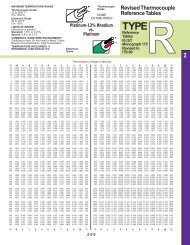Using Thermocouples
Using Thermocouples
Using Thermocouples
Create successful ePaper yourself
Turn your PDF publications into a flip-book with our unique Google optimized e-Paper software.
Distributed<br />
Capacitance<br />
220 V AC Line<br />
HI<br />
Distributed<br />
Resistance<br />
Without Guard<br />
LO<br />
DVM<br />
Without Guard<br />
HI<br />
LO<br />
Guard<br />
DVM<br />
Z<br />
Each shielded thermocouple junction can directly<br />
contact an interfering source with no adverse effects,<br />
since provision is made on the scanner to switch the<br />
guard terminal separately for each thermocouple<br />
channel. This method of connecting the shield to guard<br />
serves to eliminate ground loops often created when<br />
the shields are connected to earth ground.<br />
The dvm guard is especially useful in eliminating<br />
noise voltages created when the thermocouple junction<br />
comes into direct contact with a common mode noise<br />
source.<br />
240 VRMS<br />
In Figure 22 we want to measure the temperature at<br />
the center of a molten metal bath that is being heated<br />
by electric current. The potential at the center of the<br />
bath is 120 V RMS. The equivalent circuit is:<br />
120VRMS<br />
Figure 22<br />
Figure 23<br />
GUARD SHUNTS INTERFERING WITH CURRENT<br />
Figure 21<br />
R S<br />
Noise Current<br />
HI<br />
LO<br />
Noise Current<br />
Figure 24<br />
Notice that we can also minimize the noise by<br />
minimizing R s . We do this by using larger thermocouple<br />
wire that has a smaller series resistance.<br />
To reduce the possibility of magnetically induced<br />
noise, the thermocouple should be twisted in a uniform<br />
manner. Thermocouple extension wires are available<br />
commercially in a twisted pair configuration.<br />
Practical Precautions - We have discussed the<br />
concepts of the reference junction, how to use a<br />
polynomial to extract absolute temperature data, and<br />
what to look for in a data acquisition system, to<br />
minimize the effects of noise. Now let’s look at the<br />
thermocouple wire itself. The polynomial curve fit relies<br />
upon the thermocouple wire’s being perfect; that is, it<br />
must not become decalibrated during the act of making<br />
a temperature measurement. We shall now discuss<br />
some of the pitfalls of thermocouple thermometry.<br />
Aside from the specified accuracies of the data<br />
acquisition system and its zone box, most measurement<br />
errors may be traced to one of these primary sources:<br />
1. Poor junction connection<br />
The stray capacitance from the dvm Lo terminal to 2. Decalibration of thermocouple wire<br />
chassis causes a current to flow in the low lead, which<br />
3. Shunt impedance and galvanic action<br />
in turn causes a noise voltage to be dropped across the<br />
series resistance of the thermocouple, R s . This voltage 4. Thermal shunting<br />
appears directly across the dvm Hi to Lo terminals and 5. Noise and leakage currents<br />
causes a noisy measurement. If we use a guard lead 6. Thermocouple specifications<br />
connected directly to the thermocouple, we drastically<br />
7. Documentation<br />
reduce the current flowing in the Lo lead. The noise<br />
current now flows in the guard lead where it cannot<br />
affect the reading:<br />
Z-28<br />
R S<br />
HI<br />
LO<br />
Guard














